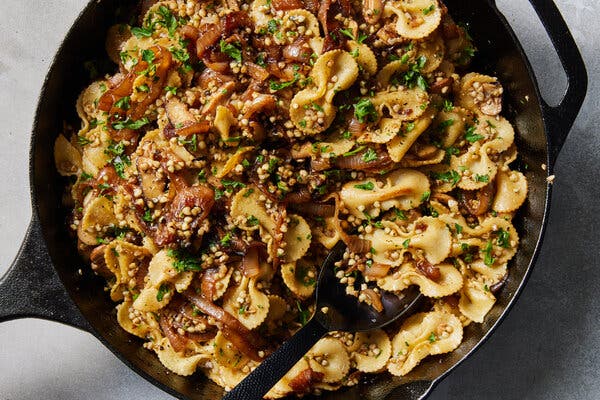Inspired by a Ukrainian cafe and a mother-in-law’s classic, this take on kasha varnishkes is rich with caramelized onions.
Listen to this article · 3:38 min Learn more
When my daughter Daniela returned from a work trip to Eastern Europe last summer, she raved about the kasha varnishkes at Kafe Jerusalem, a tiny Ashkenazic Jewish restaurant in Lviv, Ukraine. According to her, it was even better than mine.
I pride myself on my recipe, having learned it from my mother-in-law Paula, a kasha varnishkes maven who grew up not far from Lviv, so I found this news perturbing, to say the least.
Recipe: Kasha Varnishkes (Buckwheat Groats, Noodles and Caramelized Onions)
Paula’s version was a simple yet ethereal mixture of caramelized onions; kasha, the hulled groats of buckwheat berries; and varnishkes, one of several Yiddish words for noodles. But often, the dish is bland, lacking in onions with buckwheat that’s too finely ground.
Curious to know what made Kafe Jerusalem’s kasha varnishkes so special, I contacted Marianna Dushar, a food anthropologist in Lviv who focuses on the food of Galicia, which covers parts of western Ukraine and southern Poland.
“First and foremost, it’s all about the kasha,” Ms. Dushar wrote in an email, translating for the restaurant’s chef-owner, Lola Landa.
Around 1880, long before my in-laws came to the United States in 1950, a large wave of Jewish immigrants from Eastern Europe brought kasha varnishkes to the Lower East Side. Most bought their stone-ground buckwheat from Wolff’s, long the go-to for the grain. Since the 1930s, Birkett Mills has milled Wolff’s buckwheat in its an 18th-century grist mill in Penn Yan, N.Y., where it thrived in the region’s Eastern Europe-like climate. (Today, the company still sells its buckwheat widely, but because the gluten-free, protein-rich, climate-resilient grain has become increasingly popular, there are many brands, including a number of smaller producers, putting their versions on the shelves.)
Thank you for your patience while we verify access.
